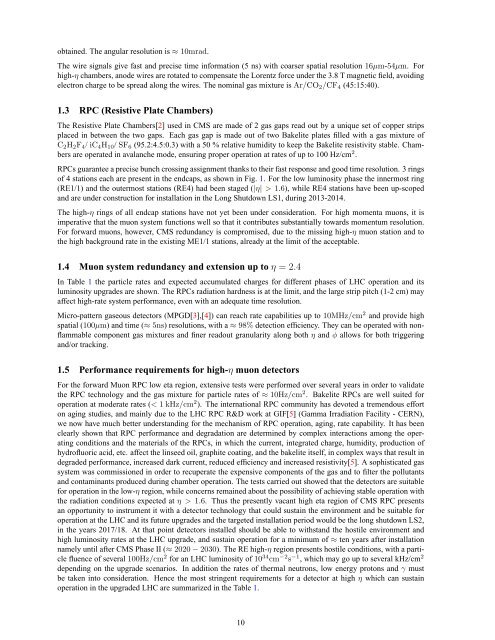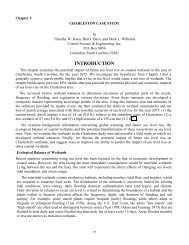A GEM Detector System for an Upgrade of the CMS Muon Endcaps
A GEM Detector System for an Upgrade of the CMS Muon Endcaps
A GEM Detector System for an Upgrade of the CMS Muon Endcaps
You also want an ePaper? Increase the reach of your titles
YUMPU automatically turns print PDFs into web optimized ePapers that Google loves.
obtained. The <strong>an</strong>gular resolution is≈ 10mrad.<br />
The wire signals give fast <strong>an</strong>d precise time in<strong>for</strong>mation (5 ns) with coarser spatial resolution 16µm-54µm. For<br />
high-η chambers, <strong>an</strong>ode wires are rotated to compensate <strong>the</strong> Lorentz <strong>for</strong>ce under <strong>the</strong> 3.8 T magnetic field, avoiding<br />
electron charge to be spread along <strong>the</strong> wires. The nominal gas mixture isAr/CO2/CF4 (45:15:40).<br />
1.3 RPC (Resistive Plate Chambers)<br />
The Resistive Plate Chambers[2] used in <strong>CMS</strong> are made <strong>of</strong> 2 gas gaps read out by a unique set <strong>of</strong> copper strips<br />
placed in between <strong>the</strong> two gaps. Each gas gap is made out <strong>of</strong> two Bakelite plates filled with a gas mixture <strong>of</strong><br />
C2H2F4/ iC4H10/ SF6 (95.2:4.5:0.3) with a 50 % relative humidity to keep <strong>the</strong> Bakelite resistivity stable. Chambers<br />
are operated in aval<strong>an</strong>che mode, ensuring proper operation at rates <strong>of</strong> up to 100 Hz/cm 2 .<br />
RPCs guar<strong>an</strong>tee a precise bunch crossing assignment th<strong>an</strong>ks to <strong>the</strong>ir fast response <strong>an</strong>d good time resolution. 3 rings<br />
<strong>of</strong> 4 stations each are present in <strong>the</strong> endcaps, as shown in Fig. 1. For <strong>the</strong> low luminosity phase <strong>the</strong> innermost ring<br />
(RE1/1) <strong>an</strong>d <strong>the</strong> outermost stations (RE4) had been staged (|η| > 1.6), while RE4 stations have been up-scoped<br />
<strong>an</strong>d are under construction <strong>for</strong> installation in <strong>the</strong> Long Shutdown LS1, during 2013-2014.<br />
The high-η rings <strong>of</strong> all endcap stations have not yet been under consideration. For high momenta muons, it is<br />
imperative that <strong>the</strong> muon system functions well so that it contributes subst<strong>an</strong>tially towards momentum resolution.<br />
For <strong>for</strong>ward muons, however, <strong>CMS</strong> redund<strong>an</strong>cy is compromised, due to <strong>the</strong> missing high-η muon station <strong>an</strong>d to<br />
<strong>the</strong> high background rate in <strong>the</strong> existing ME1/1 stations, already at <strong>the</strong> limit <strong>of</strong> <strong>the</strong> acceptable.<br />
1.4 <strong>Muon</strong> system redund<strong>an</strong>cy <strong>an</strong>d extension up to η = 2.4<br />
In Table 1 <strong>the</strong> particle rates <strong>an</strong>d expected accumulated charges <strong>for</strong> different phases <strong>of</strong> LHC operation <strong>an</strong>d its<br />
luminosity upgrades are shown. The RPCs radiation hardness is at <strong>the</strong> limit, <strong>an</strong>d <strong>the</strong> large strip pitch (1-2 cm) may<br />
affect high-rate system per<strong>for</strong>m<strong>an</strong>ce, even with <strong>an</strong> adequate time resolution.<br />
Micro-pattern gaseous detectors (MPGD[3],[4]) c<strong>an</strong> reach rate capabilities up to 10MHz/cm 2 <strong>an</strong>d provide high<br />
spatial (100µm) <strong>an</strong>d time (≈ 5ns) resolutions, with a≈ 98% detection efficiency. They c<strong>an</strong> be operated with nonflammable<br />
component gas mixtures <strong>an</strong>d finer readout gr<strong>an</strong>ularity along both η <strong>an</strong>d φ allows <strong>for</strong> both triggering<br />
<strong>an</strong>d/or tracking.<br />
1.5 Per<strong>for</strong>m<strong>an</strong>ce requirements <strong>for</strong> high-η muon detectors<br />
For <strong>the</strong> <strong>for</strong>ward <strong>Muon</strong> RPC low eta region, extensive tests were per<strong>for</strong>med over several years in order to validate<br />
<strong>the</strong> RPC technology <strong>an</strong>d <strong>the</strong> gas mixture <strong>for</strong> particle rates <strong>of</strong> ≈ 10Hz/cm 2 . Bakelite RPCs are well suited <strong>for</strong><br />
operation at moderate rates (< 1kHz/cm 2 ). The international RPC community has devoted a tremendous ef<strong>for</strong>t<br />
on aging studies, <strong>an</strong>d mainly due to <strong>the</strong> LHC RPC R&D work at GIF[5] (Gamma Irradiation Facility - CERN),<br />
we now have much better underst<strong>an</strong>ding <strong>for</strong> <strong>the</strong> mech<strong>an</strong>ism <strong>of</strong> RPC operation, aging, rate capability. It has been<br />
clearly shown that RPC per<strong>for</strong>m<strong>an</strong>ce <strong>an</strong>d degradation are determined by complex interactions among <strong>the</strong> operating<br />
conditions <strong>an</strong>d <strong>the</strong> materials <strong>of</strong> <strong>the</strong> RPCs, in which <strong>the</strong> current, integrated charge, humidity, production <strong>of</strong><br />
hydr<strong>of</strong>luoric acid, etc. affect <strong>the</strong> linseed oil, graphite coating, <strong>an</strong>d <strong>the</strong> bakelite itself, in complex ways that result in<br />
degraded per<strong>for</strong>m<strong>an</strong>ce, increased dark current, reduced efficiency <strong>an</strong>d increased resistivity[5]. A sophisticated gas<br />
system was commissioned in order to recuperate <strong>the</strong> expensive components <strong>of</strong> <strong>the</strong> gas <strong>an</strong>d to filter <strong>the</strong> pollut<strong>an</strong>ts<br />
<strong>an</strong>d contamin<strong>an</strong>ts produced during chamber operation. The tests carried out showed that <strong>the</strong> detectors are suitable<br />
<strong>for</strong> operation in <strong>the</strong> low-η region, while concerns remained about <strong>the</strong> possibility <strong>of</strong> achieving stable operation with<br />
<strong>the</strong> radiation conditions expected at η > 1.6. Thus <strong>the</strong> presently vac<strong>an</strong>t high eta region <strong>of</strong> <strong>CMS</strong> RPC presents<br />
<strong>an</strong> opportunity to instrument it with a detector technology that could sustain <strong>the</strong> environment <strong>an</strong>d be suitable <strong>for</strong><br />
operation at <strong>the</strong> LHC <strong>an</strong>d its future upgrades <strong>an</strong>d <strong>the</strong> targeted installation period would be <strong>the</strong> long shutdown LS2,<br />
in <strong>the</strong> years 2017/18. At that point detectors installed should be able to withst<strong>an</strong>d <strong>the</strong> hostile environment <strong>an</strong>d<br />
high luminosity rates at <strong>the</strong> LHC upgrade, <strong>an</strong>d sustain operation <strong>for</strong> a minimum <strong>of</strong> ≈ ten years after installation<br />
namely until after <strong>CMS</strong> Phase II (≈ 2020−2030). The RE high-η region presents hostile conditions, with a particle<br />
fluence <strong>of</strong> several 100Hz/cm 2 <strong>for</strong> <strong>an</strong> LHC luminosity <strong>of</strong> 10 34 cm −2 s −1 , which may go up to several kHz/cm 2<br />
depending on <strong>the</strong> upgrade scenarios. In addition <strong>the</strong> rates <strong>of</strong> <strong>the</strong>rmal neutrons, low energy protons <strong>an</strong>d γ must<br />
be taken into consideration. Hence <strong>the</strong> most stringent requirements <strong>for</strong> a detector at high η which c<strong>an</strong> sustain<br />
operation in <strong>the</strong> upgraded LHC are summarized in <strong>the</strong> Table 1.<br />
10
















